Forward to the Olmec //
The Magical History Tour // Back to Archaeology and Anthropology
American
Indian
Links
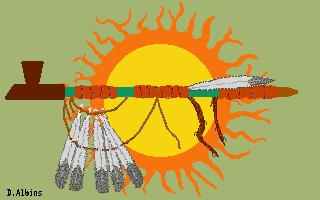
To Lecture Notes
Get in the mood with this excellent Youtube presentation.
Other American Indian Youtube sites:
Women Dancing
Men's Fancy Dancing
Pow Wow
50 Years of PowWows
American Genocide, the Trail of Tears
Robbie Robertson Ghost Dance
The Sioux
Honoring Native American Women, Pt. 1
Honoring Native American Women, Pt. 2
Native American Warrior
Blaze of Glory
Native American Warriors Tribute
Great Chiefs
Natives of the West
Native American Genocide
Power Drums - Ghost Dance
"Buffalo Soldiers" by Bob Marley
Bison Jump
Wounded Knee
Index:
To General American Indian Resources on the Internet
History 1301 -
American Indian Links to 1878
History 1302 - American Indian Links - 1878 - Present
To Texas Indians
To Humanities Capstone Program - Caddo, Hopi, Navajo, Zuni
Ancient Pueblo Peoples
To Other Specific Indian Nations (other than Texas & Capstone Program)
Civil Rights
Recent Publications by American Indians
To American Indian Arts and Crafts
To American Indian Stories and Oral Traditions
American Indian Food
American Indian Spiritualism/Religion
Games and Sports
El Centro's Archaeology, Anthropology, and Rock Art Links
American Indian Genealogy
Maps
Lecture Resources
General American Indian Resources on the Internet
Native Americans - Wikipedia
WWW Virtual Library - Native Americans
National American Indian Heritage Month
American Indians (Links)
First People
National Archives Pictures of Native Americans
Native American Indians Links
Native Peoples Magazine
Indianz.com - Current news, articles
Awesome Library - Native American - Teacher-oriented links, maps, materials
Native Americans - National Portrait Gallery
Native-American.Com - "Everything" Native American
NativeTech: Internet Links to Native American Resources
NativeWeb Resources by Nation
Links to American Indian Sites
Native Web Site Evaluation
American Indian Links
Links to Native Sites
This Week in North American Indian History
American Indian Tribal/Nation Home Pages - Links
World History Archives: Indigenous Peoples of the Americas
Tribal Directory
American Indian Biographies
Civil Rights Movement & Photos
 Russell Means
American Indian Movement (AIM)
National Congress of American Indians
Russell Means
American Indian Movement (AIM)
National Congress of American Indians
American Indian Arts and Crafts
To Literature/Stories/Myths //
Pottery Page
Native American Art Exhibit
National Museum of the Native American
Native American Indian Art
Lots of Rock Art Sites
American Indian Stories and Oral Traditions
Native American Resources - Stories & Prayers with Exercise
Indigenous Peoples' Literature
Apache Creation Story
Aztec Creation Story
Teaching the American Literatures
Recent Publications by American Indians
American Indian Spiritualism & Religion
A Brief History of the Native American Church
American Indian Games and Sports
LaCrosse History
American Indian Food
American Indian Genealogy
American Indian Maps
Geography Page
History 1301
The First People of Texas
North American Indian Historical Sites
Hopewell Culture National Historical Park
Aztecs and Incas
Early Pueblo Peoples (Anasazi)
Hohokam, Mogollon, and Cochise Peoples
Texas Indians
Hopi, Navajo, Zuni, and Caddo - The Capstone Program
Plains Indian Smallpox
Archaeology and Anthropology
Pottery Page
American Indian Sign Language
See the Colonial Period for more about American Indians
History 1302 - American Indian Links
Geronimo, His Own Story
The Overland Trail Links - Plains Indians
Imaging and Imagining the Ghost Dance
Zitkala-Sa
Zitkala-Sa Images
Zitkala Sha
Sitting Bull
PBS Sitting Bull
Sitting Bull Biography and Quotes
Sitting Bull In Memory
PBS Crazy Horse
Ta' Shunke Witko (Crazy Horse)
George A. Custer
PBS George Custer
Sand Creek Massacre
 Sand Creek Massacre National Historic Park
Sand Creek Massacre National Historic Park
Sand Creek Massacre
Red Cloud's War
Red Cloud
Battle of Little Bighorn
Little Bighorn Battlefield National Monument
Legends of America: Battle of Little Bighorn
Chief Joseph of the Nez Perce
The Dawes Act
Buffalo Soldiers and Indian Wars
 Buffalo Soldiers National Museum
Buffalo Soldiers National Museum
Indian Scouts - Wikipedia
Topic 1: American Indians
Our first topic is American Indians. I need to clarify some words. One thing is that I use the term American Indians. Some people use the term Native Americans. Either is correct. Most American Indians refer to themselves by their nation such as Cherokee, Apache, and Choctaw.
American Indians were the first conquerors of the New World. What does the term New World mean? Some people object to that term. But, it actually is accurate. The New World was new to American Indians at one time. At the same time there is disagreement as to where American Indians originated. Many American Indians believe that they were created in the New World. Others believe they immigrated from Asia and the old world. One thing we know is that people had arrived in the New World at least 37,000 years ago.
Some believe they migrated from Asia by crossing Beringia. This was a submerged isthmus that connected Asia and North America. Perhaps, some came by boat.
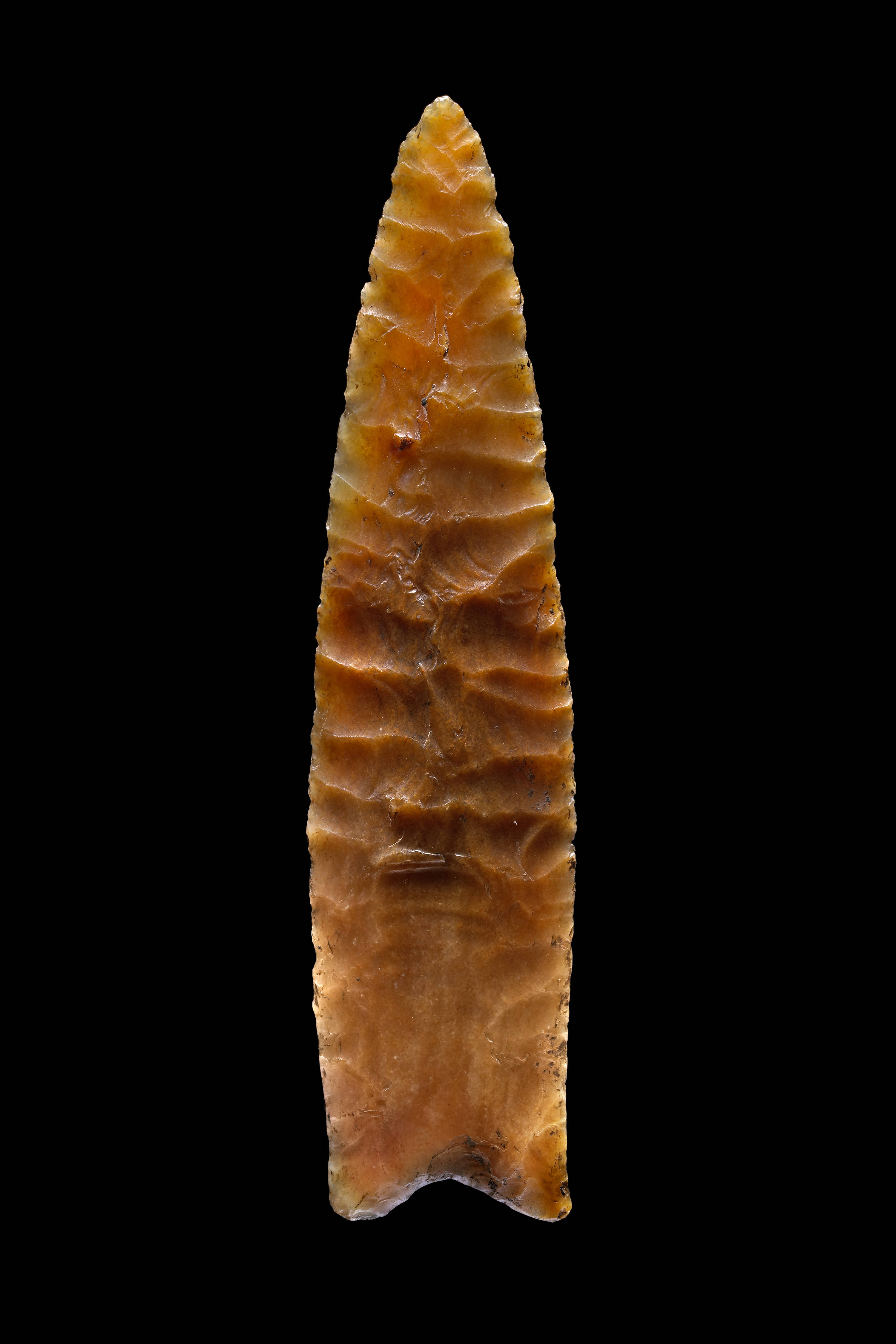 Clovis Point
Clovis Point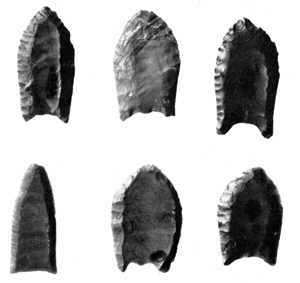 Folsom Points
Folsom Points
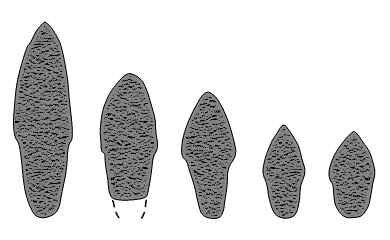 Plano Points
Plano Points
The first inhabitants of the New World are called Paleo-Indians/Paleo-Americans. Paleo means old. There were three groups of Paleo-Americans. There were the Folsom, Clovis, and Plano. Some of these people live along the Trinity River. We don't know much about them but they were big game hunters. It is not known what happened to them. Either they disappeared or more likely changed so much that they became unrecognizable by 8000 B.C.E. Note: B.C.E. it the new B.C. meaning before the common era. CE means the old A.D. CE means the common era. (See for more lecture notes and links about Paleolithic Americans.
There were at least two major waves of immigration to the New World. Most of these people came from Asia and continued up to 20,000 years ago. Over thousands of years the American Indian cultures recognize today began to develop. They dispersed throughout the New World. As they first, they diversified. What caused this diversification?
Most of this diversification came after the development of agriculture during the so-called Archaic period. (8000-1500 BCE) agriculture allowed some American Indians to become sedentary and stay in one place. In general sedentary people are able to develop more complex social, religious, political, and artistic cultures. At the same time, they left more artifacts. Many of the nomadic cultures such as the Comanche have very complex lifestyles.
One thing for sure, though, American Indians were and are diverse and difficult to study because there are few generalizations. You can't say all Indians do anything. Diversity makes stereotyping people easy. What is a stereotype? Do people stereotype you? What is the common stereotype of an American Indian? Even though you know it's wrong, you cannot help it. It has been emblazoned in your brain.
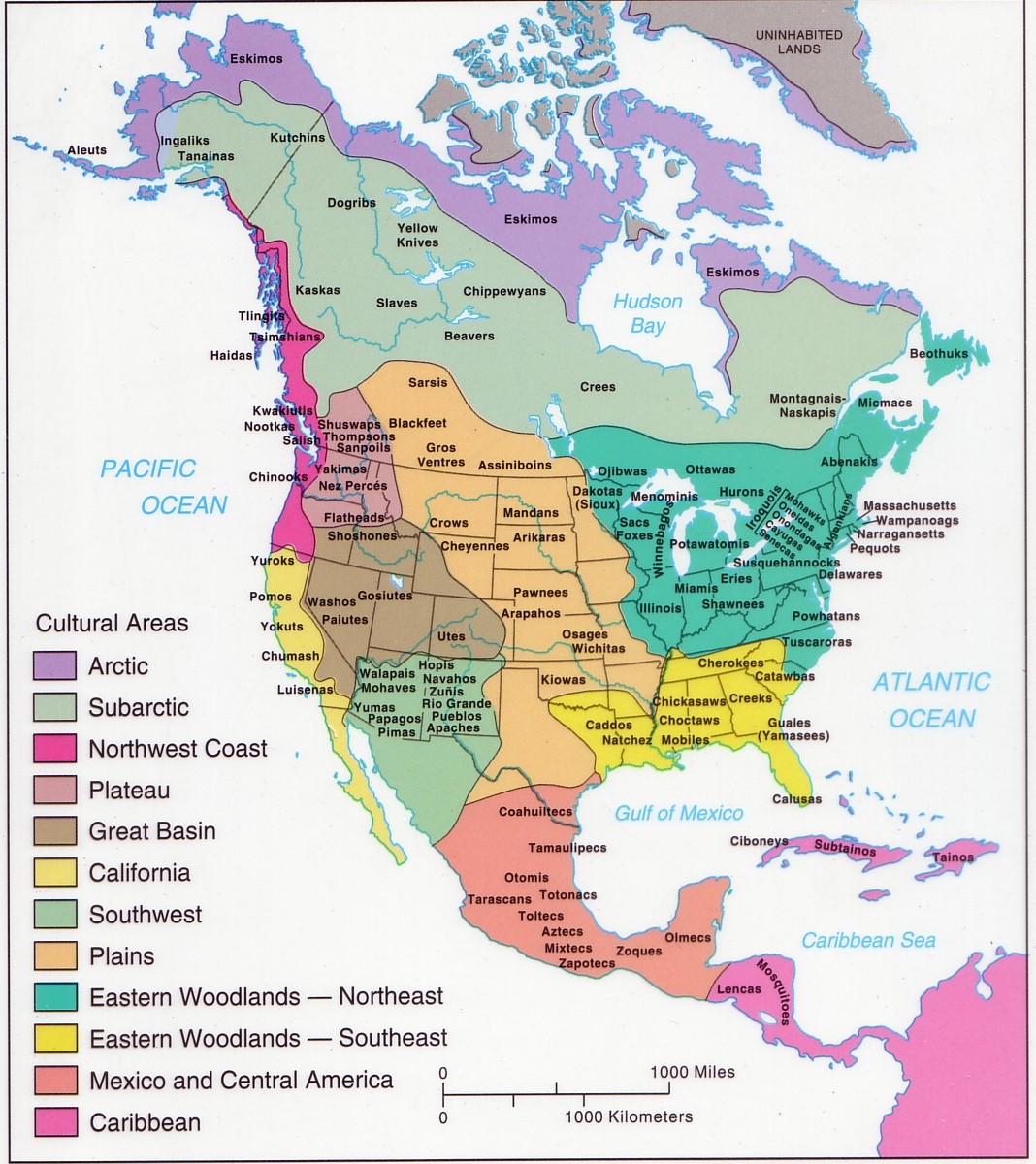
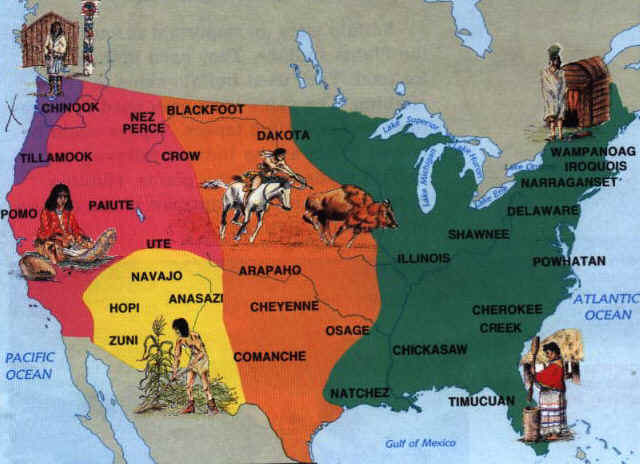
Some of the most complex cultures developed within two Woodland cultures him and - the Northeast and Mississippian. They had a long history before the Europeans arrived. By 2000 B.C.E., the Adena-Hopewell people or Moundbuilders lived in the Ohio Valley region. This culture included a large population, complex religions, and carved ornaments. They also built thousands of mounds or sculptured earth works. Some of them reached 70 feet high. There were 10,000 in Ohio alone. The first Europeans in the area attributed them to a mythical race and denied the Indians were capable. Shortly after the Europeans arrived, moundbuilding stopped although it has begun to decline as early as 500 CE.
As Adena-Hopewell culture declined, other Woodland cultures developed including the Eastland Woodland culture group. There were two dominant language groups, the Algonquins and the Iroquois. Over 100 Algonquin nation included in the Delaware, Shawnee, Kickapoo, Chippewa, Wampanoag, Powhatan, and Pottawatomie. In general they saw the Iroquois as their enemies. The Iroquois included dozens of nations such as the Mohawk, Oneida, Huron, Erie, and Tuscarora.
The Iroquois were best known for their confederations. A Confederation is a group of nations united for a common purpose. The most famous was the Five Nations of the Iroquois (later six). The Iroquois attributed creation of this Confederacy to Hiawatha. Although there were hostilities between the Woodland nations, they had similar cultures and lifestyles. All emphasized agriculture, complex religions, and high status of women.
Meanwhile, a very complex Woodland culture developed in the region of the Mississippi River to East Texas and the Atlantic coast known as the Mississippian peoples. It emerged by 1000 CE. It included the Caddo, Creek, Choctaw, Cherokee, Alabama, Tuskegee and many others. They built the first known city in today’s United States, Cahokia. It was located near St. Louis with a population of 40 to 50,000 people. It had urban centers, markets, fortifications, advanced arts and crafts, a complex government and economic system. It also included some moundbuilding. It was deserted by the time the Europeans arrived. We do not know who lived there or what they call themselves. The term Cahokia was given to the Europeans by people who lived in the area after it had been deserted.
Meanwhile, very different cultures developed in the Great Plains, both sedentary and nomadic peoples. They included the Kiowa, Comanche, Ponca, Mandan, Lakota (Sioux), Dakota (Sioux), Arapahoe, Cheyenne, Crow, and Pawnee. The nomadic peoples like Comanche, Kiowa, and Lakota will be some of the most affected by the Europeans with the introduction of the horse and guns. While Great Plains people underwent dramatic change, other cultures were less affected by the European arrival. This included the Sub-Arctic and Arctic regions including the Eskimos and Aleut.
To the South of the Arctic region, two northwest cultures developed, the Northwest Coastal peoples and the Northwest Plateau peoples. The Coastal peoples included the Chinook and Tlingit and were known for their woodworking including totem poles. Totem poles represented the clan utilizing images of animals.
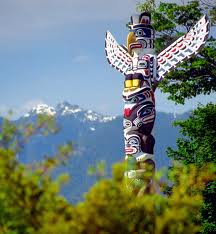
Coastal nations were also known for the "Potlatch." This was a ceremony in which a party was given and the host gave away his/her wealth. Potlatch means "to give."
The Northwest Plateau peoples included the Nez Perce and Klamath. They depended on salmon for their way of life.
To the south of them, the California peoples thrived including the Mohave, Pomo, Yuma, and Hupa. The mild climate and abundant food provided the needs for a very diverse population with approximately 100 different dialects. They included the tallest American Indians (Mohave) and the shortest (Yuki). They were mostly gatherers (acorns) and fisherman although the Mohave also had agriculture. California peoples tended to be peaceful but did guard and protect their territorial claims to oak trees. The Mohave were more warlike than others in that region. The Pomo actually said the war ended when the first drop of blood was spilled.
To the east of them were the peoples of the Great Basin including the Ute, Paiute, and Shoshone. (Originally, the Comanche lived in this region, too, but moved east to the Great Plains. "Comanche" is actually a Ute word meaning "he who wants to fight all the time." The Great Basin was a harsh environment (think of the Las Vegas area) so there was a sparse population and not warlike.
To the South of them, the Southwest peoples lived including the Athapaskan and Pueblo Indians. The Athapaskans included the Apache and Navajo who had migrated from the northwest. The Navajo practiced agriculture while the Apache lived a lifestyle similar to the Plains Indians. The Pueblo peoples are often referred to as Anasazi but they do not like that terms since it's Navajo for "my enemy." The Pueblos included the Zuni, Hopi, and Pima and probably migrated from the south since they reflected Mesoamerican traits with planned villages and large terraced buildings.
Mesoamerica covers the area from around Tampico, Mexico, through Honduras and included the Olmec, Maya, Aztec, Toltec, and many other cultures. The Europeans arrived at the peak of Aztec power in Mesoamerica. They controlled many other peoples and built a great city, Tenochtitlan, in the location of Mexico City today. In addition, the Aztecs had a powerful leader, Moctezuma II.

There were other American Indians in South America such as the people of the Inca and the three nations in the Caribbean. The point is that American Indian culture was and is diverse and difficult to study because few generalizations work. But, let's give it a try anyway.
One interesting question still debated today is were they civilized. The definition of civilization varies but generally includes such accomplishments as an economic system, a political system, interest in science and the arts, spiritual development, building stone monuments, and writing. The last two are the debatable ones. With that definition, only the Aztecs and Mayans would have been considered civilized. Only they had writing at the time the Europeans arrived. So anthropologists agree they were civilized. But, is that the correct definition of civilization? And is civilization a good thing or bad thing? The Gypsies liked to brag they were not civilized and did not want the problems associated with civilization like advanced warfare, low status of women, and strict rules, regulations, and taxes.
No one area demonstrates the diversity of American Indians like communication. It is unknown exactly how many languages existed but up to 2,000 has been suggested but only the two with written language. Even then, oral tradition dominated. Despite the diversity of languages, American Indians could communicate with each other although contact was limited prior to the arrival of horses from Europe. Think about it a moment. How do we communicate without using speech?
One way American Indians communicated was through sign language. It is unknown how it developed, but Indians say it was a "gift from the gods" so I guess that's good enough for us. Check out some of the signs. There are four parts. If you have children, they really like learning the signs.
Art, of course, is another way we communicate and American Indians loved art. They had an interesting philosophy about who are artists. When you were young, did anyone tell you that you could not draw? Did others say you color outside the lines? Well, that would not happen in American Indian culture because they believed everyone was an artist. Because of this, art was on everything. Women were particularly important since they made the objects with the art on them including baskets, pottery, clothing, and their homes. They also were known for their rock art in caves and on cliffs. I encourage everyone to visit the Dallas Museum of Art and see the art on display there. Here is some information about the art at the museum although it changes regularly. It would make a great Field Trip for your Final Exam.





Another way people communicate is through music and dance. There are some links at the top of this page with examples of both. Try to do the dances yourself. You may do Dance Analysis Worksheets or Song Analysis Worksheets for Final Exam points, too.
Another form of communication is the use of our bodies including clothing, piercings, paint, hair styles and tattoos. Many American Indians were very involved in tattoos especially in Texas where almost every nation had elaborate tattoos. Of course, their tattoos had a meaning. Do you have tattoos? What do they mean to others? There is a tattoo exercise for the Final Exam.

What do you think my newest tattoo means?
Paint meant different things to different people and its importance varied. Among Comanche it was very important and they carried paint wherever they went. Women also used facial make-up on their eyes, ears, and chests. But, among the Creek women, only prostitutes wore body paint. On the other hand, Aztec women loved yellow and wore it on their cheeks.
Hair was also important to American Indians and said something about their cultures, too. That they had time to do complex hairdos meant they had enough leisure time to do such things. Huron men shaved half and left half of their hair in roles. Creek men shaved their heads except for a strip down the middle and a fringe at the brows. Delaware men shaved their heads but left a lock down the center of their heads. Comanche men wore long hair and even tried to make it longer by getting cuttings for women to add to their own to make the braids longer. Women wore their hair long, braided, in buns and roles, twisted and usually decorated. One of my favorites was the "Squash Blossom" shown on my Hopi page.
Clothing was also diverse and revealed such cultural aspects as climate and resources as well as status and wealth. The loincloth or breechclout was universal among men. Aztec men added a cloak if they were wealthy. Leggings were also common. Most women wore skirts. Creek women wore skirts knee length with calf-high mocassins. Aztecs wore ankle length skirts with a blouse. Plains women wore beautiful buckskin dresses with fringes that blew in the wind. Apache women wore pants or dresses while the men wore very little at all. The lack of clothing, especially among the women, will disturb the Europeans when they arrive. Most American Indian women did not wear tops unless the climate required it. The exposure of their breasts offended the Europeans. Have you ever wondered what it would be like to live in a society where all the women were topless from your mother to your wife? How would that change the symbolism of breasts in a culture?
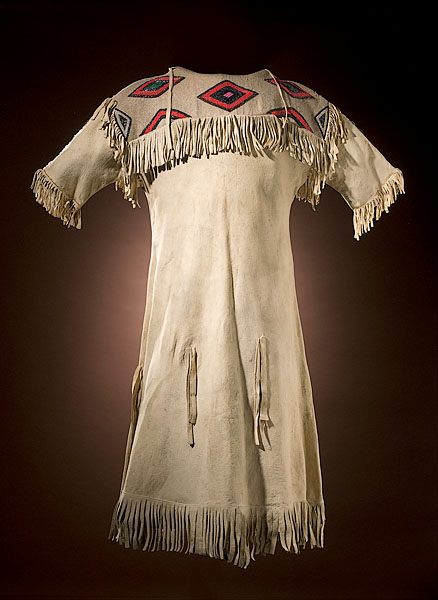
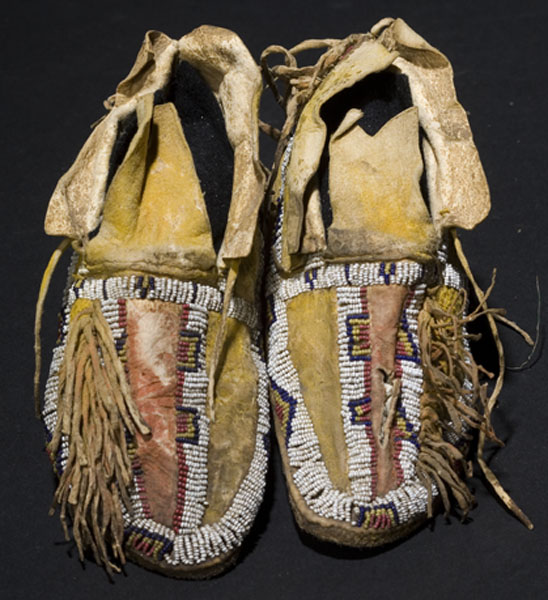
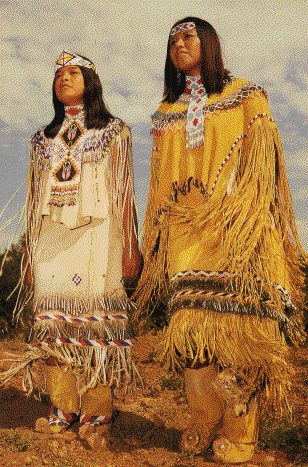

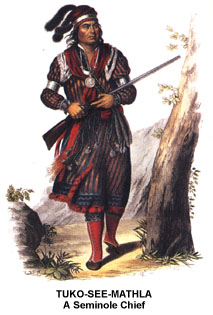
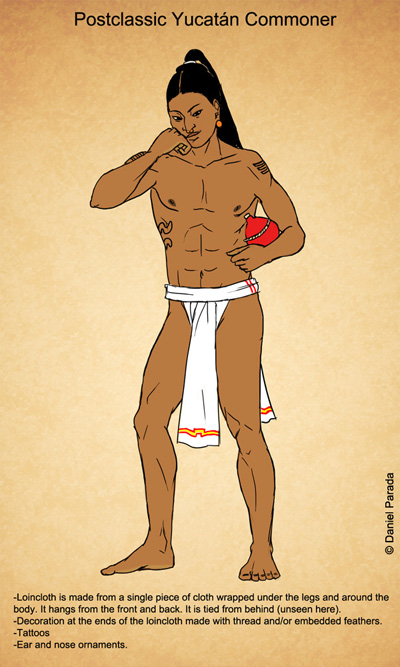
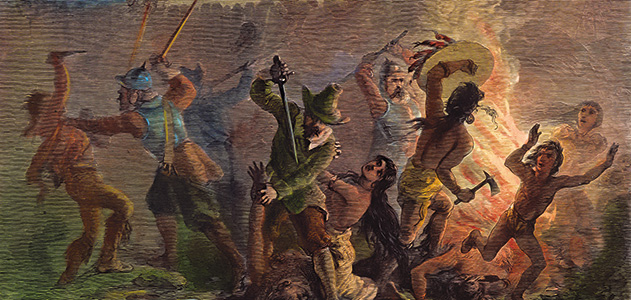
This does not mean European did not like anything about American Indian culture. Necessity forced them to adapt to American Indian housing since that was all that was available at first. Again, housing exemplified the diversity of their cultures. Most Woodland peoples lived in Longhouses, large wooden structures that housed 60 to 80 people arranged in villages with a meeting house, sweathouse, dance house, and stockades. The Caddo of East Texasw lived in round huts of wood and thatch. This page has a photo I took several years ago of a recreation of a Caddo House by students from the University of Texas. Unfortunately, some idiot burned it down. The most famous housing was the tipi but it was used mainly by the Plains People and made out of bison hide. The Northwest Coastal people lived in wooden plank homes with floors and front porches. Of course, Eskimo/Aleuts lived in igloos. In the Southwest, they lived in adobe homes while Aztecs lived in huts with a thatch roof or sometimes made of stone, mudbrick or adobe. One common trait of American Indian housing was the even the wealthy usually had simple interiors with mats, a place to cook, a religious area, baskets, and containers. This was even truer of nomadic people. Women had to move their families' possessions so they kept it simple since they only had help of dogs.

Europeans also appreciated American Indian economic systems. They had a variety of activities ranging from the simplest hunter/gatherers to complex agricultural systems and trade networks. For most American Indian men, hunting and/or fishing was the overriding concern. At first, Europeans did not understand hunting. In Europe it was just a sport like the fox hunt. Most of the wildlife there had been wiped out. They did not hunt for food or clothing. But, Europeans learned to appreciated hunting especially when it came to beaver pelts. To hunt, men used bows and arrows, spears, and traps. They also used bison jumps where they ran a herd of bison over a cliff to kill them. The oldest known bison jump is in West Texas. There is a link at the top that explains the bison jump.
For fish, men did the same things we do today. They used nets and hooks with lines including trot lines. They also caught water fowl by swimming beneath them and grabbing their legs. American Indian men had to prove their abilities to hunt or fish to get married. No American Indian woman would marry a man who could not provide for her and her children. (I think that's a good lesson.)
Most cultures had taboos on some animals. The Comanche did not kill turkeys that would show them to be cowardly. The Shoshone and Comanche did not kill coyotes due to their human-like qualities. It brought bad luck to kill them. The Aztecs would not kill or eat rats of snakes but did eat coyotes. Aztecs also enjoyed shrimp, rabbit, armadillos, gophers, dogs, and frogs.
Despite the hard work the men did, most American Indians depended on agriculture for the majority of their food and trade goods. Europeans will like this very much. They did not understand, though, why women were usually the farmers. In Europe, farming was man's work but not in American Indian culture. Today is widely believed that women invented or discovered agriculture. As they gathered natural food, they observed that plants appeared where seeds had been dropped so they took that and created agriculture by purposefully planting seeds. They were great farmers, too.
American Indians grew over 80 crops and most were not available in Europe. This included corn or maize, peppers, tomatoes, avocados, peanuts, chocolate, numerous grains, potatoes from South America, tobacco, and cotton fiber. Corn or maize was the most important. Almost all nations grew corn and tobacco. American Indian women were also creative cooks. Aztec women, for example, made 40 kinds of tamales including frog, snail, turkey egg, bean, pepper, fish, rabbit, fruit and mushroom tamales.
Women supplemented the diet by gathering everything including honey, maple syrup, nuts, berries, roots, insects, and larvae like the yellow jacket that was used for soup. Women also were the traders which will annoy the Europeans since men in Europe did most of the trade. Europeans will reject women's role in trade and insist that men did it and that altered their traditional cultures.
Europeans rejected other aspects of American Indian cultures especially in the area of religions. Europeans, including Christopher Columbus, will conclude that Indians had no religions. Nothing could be less true although religion varied in importance and complexity. Most had many gods and spirits but others worshiped a "Great Spirit." Religion usually emphasized nature and was this life oriented while vague about the afterlife.
Most villages and bands had a shaman, a spiritual leader, healer, and mediator between gods and humans. Shaman could be men or women, especially post-menopausal women. But, the importance of the shaman varied. For Eskimos the shaman had little status and vague roles. It was a part-time job among the Creek. On the other hand, the Pomo in California had shaman who had high status and importance. Among the Plains Indians the shaman was often a gay man who served as a full-time specialist, foretold futures, and led the Sun Dance.
The Sun Dance will upset the Europeans and is illegal today although still practiced. It was a religious ceremony that proved the four virtues of men: bravery, generosity, strength, and integrity. It was a flesh sacrifice. The men would be pierced in the chest and tied to a pole where they dangled. They were supposed to accept it with laughter. Do any of you men want to prove you have the four virtues?
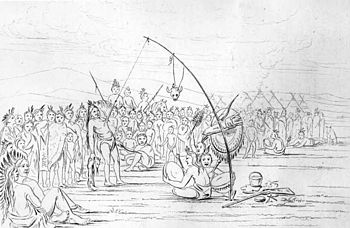
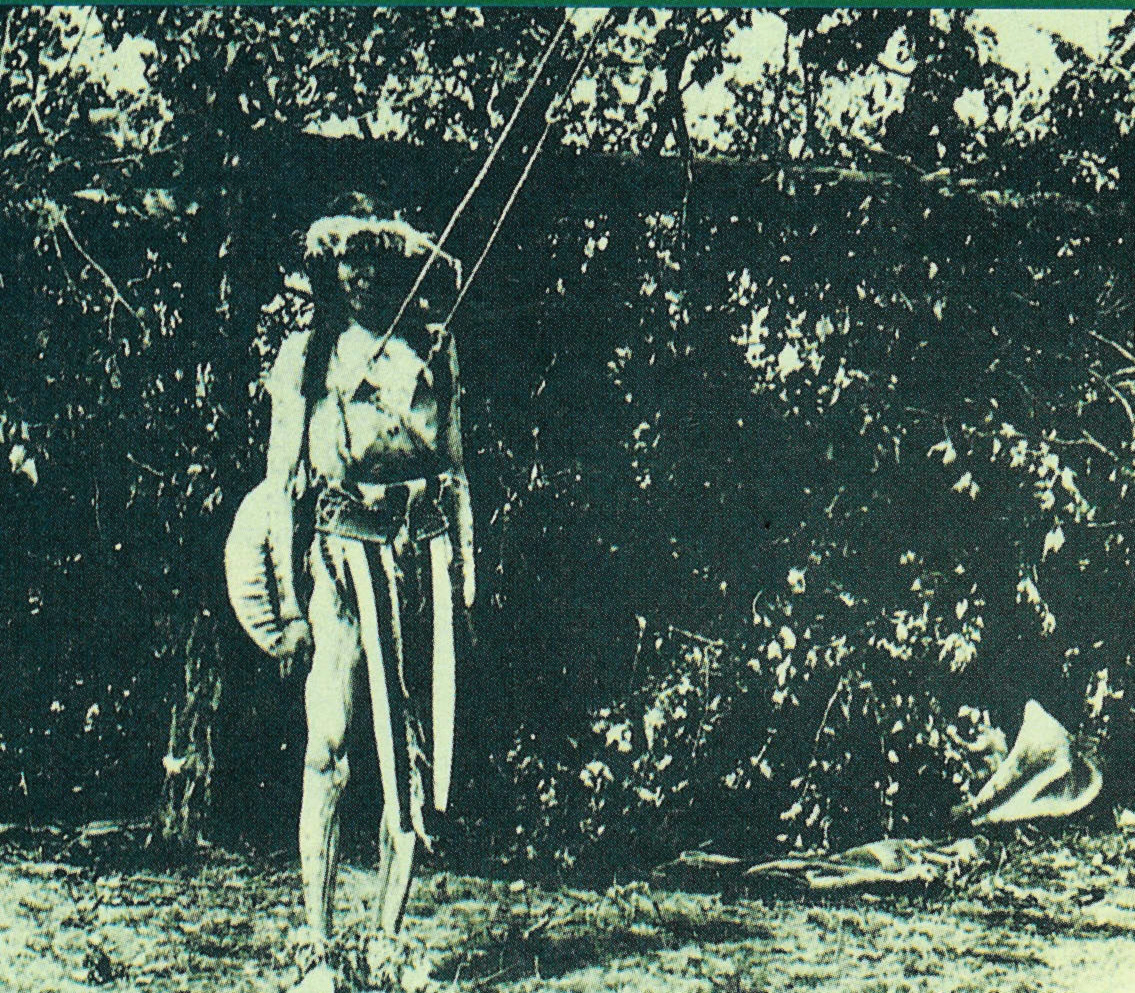
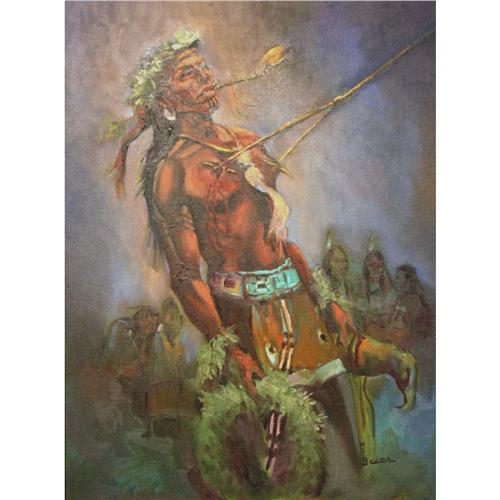 While shaman could be important as in the Sun Dance, their power was limited and they could be easily removed from their positions if they failed. The main job was to figure out why people died or became ill. The views about death varied, too. Some had little in the way of ceremonies while others had elaborate ceremonies. The Aztecs view of death was very complicated. They believed in several paradises, nine hells, and held the Feast of the Dead yearly. This was the origins of today's Day of the Dead. The fear of ghosts and the dead was common. Many nations destroyed the property of the deceased and never mention his/her name after death. But Indian religions were mostly about life not death.
While shaman could be important as in the Sun Dance, their power was limited and they could be easily removed from their positions if they failed. The main job was to figure out why people died or became ill. The views about death varied, too. Some had little in the way of ceremonies while others had elaborate ceremonies. The Aztecs view of death was very complicated. They believed in several paradises, nine hells, and held the Feast of the Dead yearly. This was the origins of today's Day of the Dead. The fear of ghosts and the dead was common. Many nations destroyed the property of the deceased and never mention his/her name after death. But Indian religions were mostly about life not death.
Dreams were an important part of most religions. The Iroquois said they revealed the desires of the soul which caused problems if they had unattainable desires. Some used hallucinogens like peyote from cactus and psilocybin mushrooms to bring about visions and enlightenment.
Some religions were very personal like the Plains Indians who believed in a "vision quest." Others, however, had priests and temples like the Caddo and Aztecs. Some, especially Aztecs, practiced human sacrifice. By the 1400s Aztecs were sacrificing 10-50,000 people a year. Most of them went willingly to go to Paradise. Aztecs also had priests who did not marry. They prayed five times a day and astrology was important, too. It was similar among the Pueblos who had endless ceremonies with religion permeating every aspect of life.
The Europeans will condemn American Indian religions and insist on conversion to Christianity. They were totally baffled that the Indians resisted the opportunity. Europeans believed anyone who was not a Christian, specifically Catholic in the early years of exploration, went to hell.
Europeans were also confused by American Indian governments. In general, they were much more democratic than what Europeans understood as government. Like Europe, however, they were usually led by men although some nations had Queens like in Europe. Most had a "war chief" and a "peace chief." Chiefs had to rely on public opinion and consensus to retain power or they were easily removed. For most, the council system dominated with elders and other respected men and women in their councils. But, they could not order people around. Decisions had to be made collectively so the power of persuasion was important. If some disagreed, they could leave and establish an new band. Some nations also had complex confederacies like the Iroquois, Creek, and Caddo with complex governments.
Others had simple governments. The Dakota only had a true government during a communal hunt. The Comanche government was based on family groups and bands and had the freedom to come and go. Many were governed by the band and had no tribal governments such as the Apache, Eskimo, California peoples, and among the Northwest Coastal peoples. Most had no laws, ordinances, sheriffs, judges, or jails. Fear of gossip, beliefs in evil spirits, being "shamed," or being ostracized kept most people in line. Criminal behavior usually was resolved by empowering the victim or victim's family. The Creek avenged murder by the killing of the murderer's brother. Others handled thieves by giving the victim all the thief's possessions. Among most nations, adultery was a serious crime that led to harsh punishment such as beating, cropping of ears, nose, or lips. Some even executed adulterers. Treason and bribery were considered crimes against society and led to capital punishment. One government system that really shocked the Europeans was that of the Iroquois. Women chose the chiefs. They also could remove the chief referred to as "dehorning."
The Europeans were more comfortable with Aztec government since it was similar to their own. Aztecs had a complex bureaucracy and were authoritarian. Class structure existed including nobility and dictators who ruled. They had high taxes, strict laws, and required military service for men. One reason the Aztecs were easily conquered was their system of government created resentment and Europeans were able to encourage dissent and rebellion.
While the Aztecs were conquered relatively quickly, Europeans had a hard time overall. American Indian warfare was very effective. They practiced guerrilla warfare that Europeans saw as unfair. Guerrilla warfare consists of sneak attacks, hit and run offensives, and camouflage. It took until the 1890s to finally conquer all the American Indians in today's United States. Some in Mexico were never defeated and still live relatively traditional lifestyles in the southern mountains of Mexico speaking their indigenous languages.
European warfare consisted of the two sides lining up in a field facing one another and then attacking. American Indians thought that was stupid to stand there dressed in red waiting to be killed. Prior to the Europeans, Indian warfare was generally brief with few killed. War was usually for revenge of personal glory. Plunder was important, too. In the Plains including Texas, they often used the "coup stick." Touching the enemy with the coup stick was as good as the kill. But, attitudes about warfare were diverse.
Some tried to avoid it like the Havasupai who moved to the bottom of the Grand Canyon to avoid conflict. For others, though, war was important. Creek men were expected to achieve distinction in war to be real men and secure the eagle feather. The Northwest Coast peoples conducted war to capture slaves. Most American Indian cultures were slave cultures. For some, war was very important. The Plains Indians believed war brought men status. The Aztecs conducted almost constant warfare to bring warriors honor, status, and to move up in class. The Comanche believed "the brave die young." And, Indian warfare could be brutal. Villages were burned while male captives were tortured by women who mutilated them before killing. Women and children who were captives were usually not killed but enslaved instead. The Karankawa on the Texas coast took a nibble from the flesh of their victims to gain his strength.
At the same time, warfare did not dominate Indian cultures until after the Europeans arrived. Like most people, family dominated life. Yet, again, the Europeans misunderstood. The main problem they had was the roles and status of women. In general, American Indian women had a higher status that European women. Since they had an important economic role as farmers, they had power. Male dominance was blurred. Most American Indians lived in matrilineal societies where families were defined by the female line. It was her house, her territorial claims, her garden and her crops. Most had free will in marriage unlike Europeans who had arranged marriages without freewill in whom to marry. Divorce was generally easy by the wife putting the husband's possession outside the house. He just left. When divorced, women almost always kept the children but the father had to support them.
Still, American Indian women were not totally equal. Most slaves were women. Women served as beasts of burden with their dogs. The penalty for adultery was generally harsher for women and most were banned from political leadership. Aztec women were expected to be meek and obey the master of the house, serve food to the men, and they ate later if guests were present. But, even Aztec women had more rights than European women. They could own a business or property, they did not lose rights when they married, could use the courts, and work in number professions such as midwives and matchmakers.
One interesting aspect of the lives of Indian women was most were isolated during their menstrual cycle. Men believed women became very powerful and drained the strength of men during their periods. So, women were sent on retreat at menstrual huts. There they practiced their arts and religions. Since women who spend a lot of time together tend to develop the same cycle, it was a time for friends to get together. Now, is this discrimination against women or the greatest idea in history?
The onset of menstruation was a very important event in a woman's life. It meant she was ready for marriage like in most cultures. Again, this event was treated differently by different nations. Some had no ceremony but others had ceremonies and public announcements. The woman's father might walk through the village to announce his daughter was menstruating. Men generally married when they were older because the tests for manhood were more strenuous. Aztec men married at 20 but Comanche men not until they were 25 to 30. Older women (today's cougars) were very popular with men. Widows and divorcees had knowledge about marriage.
Courtship was important for most American Indian women, too. They expected serenades, gifts, open affection, and sexual relations. Chastity was important for some nations like the Shoshone and Dakota. There was a high rate of chastity among Comanche women since they had to make the first move in a courtship. For most, there was no major ceremony to marry. They just moved in together and the first child sealed the union. Of course, the Aztecs were different. They had a major ceremony with speeches and a feast given by the bride's family. Some like the Creek had a "bride price" or gift to the woman's family.
Most American Indians were monogamous but polygyny was allowed if the man could afford more than one wife. We are used to the term polygamy but that simply means one spouse has more than one spouse. It does not specify if it's the wife or husband, though. Polygyny is specifically the husband having multiple wives. Generally, American Indian men married sisters (How would you like that?). He also had to get permission from the first wife. A few nations practiced polyandry in which wives had multiple husbands such as the Eskimos. Since they lived in such a harsh climate, it might take more than one husband to support the family.
Most American Indians banned marriage to a relative but accepted gay and lesbian couples. There were exceptions to this. Some nations executed gays and lesbians. Others, though, were very tolerant. The berdaches were in the Eastern Woodlands. Berdaches were men who dressed and performed the roles of women. For most, however, the purpose of marriage was to have children.
American Indians were tolerant, indulgent parents. Few used corporal punishment such as spanking although the Aztecs did. For most, though, childhood was a carefree time that included a long period of nursing that might last four years or more. Women were not allowed to have sex while nursing so this provided a natural spacing of children. Like Africans, American Indians believed it took a village to raise a child. The entire community was involved although it was usually gender-oriented. Children were taught to think for themselves and act for the community. They also enjoyed many games and sports. Children and adults played ball games, dice games, had footraces, wrestled, had target games, and board games. At the same time, visiting and socializing was important. American Indian hospitality will be tested when the Europeans arrive.
There were some ways that American Indians were vulnerable to the European invasion that began in 1492. First, the attitudes of the Europeans made them vulnerable. Had Europeans came with an attitude of acceptance and equality, history would have been very different. They did not. Although it's difficult for us to comprehend, Europeans were convinced of their superiority. They wanted to subdue people. They saw land as something to own which was incomprehensible to American Indians. They borrowed the land. They believed you could not own anything if you could not take it with you when you move. Because of this, Europeans will be able to take advantage of American Indians.
Another thing that made Indians vulnerable was their inability to create a pan-Indian resistance or all Indians coming together to resist the Europeans. They did not see themselves as "one people" or a race of people. Europeans were able to exploit the conflicts between nations and added guns to the equation.
Disease also made the American Indians vulnerable. They had no immunity to European diseases such as small pox, measles, and influenza. It is estimated that up to 90% of American Indians died of disease within a few decades of the European arrival.
Another area of vulnerability was European alcohol. They were unaccustomed to the strong spirits of Europe although they made alcoholic drinks similar to beer. Of course Europeans encouraged them to drink alcohol and it became a favorite trade good.
Trade was also a vulnerability. American Indians wanted the things Europeans brought so altered their own economies for trade. Meanwhile, they became dependent on European trade goods which increased warfare such as over the beaver trade. The role of women in trade was also altered.
American Indians were also vulnerable because a weakening of their cultures through intermarriages with Europeans. A new ethnic group was created, the mestizos who were part American Indian and part European (usually Spanish). Indian heritage tended to be lost in these relationships.
Technology was another vulnerability. American Indians had no wheel except for toys since they had no animals to pull wagons or carts. They did not smelt iron and had no guns.
Of course, in 1492, American Indians had no way of knowing what was coming. Perhaps if they could have communicated with Africans, they would have known because the contact between Africa and Europe was ancient. At the same time, Europeans had a totally different relationship with Africans. And, that takes us to our next topic, Traditional African Culture.
NOTE: See other pages related to specific nations on the links at the top of this page below "Index." Most have overviews of the cultures as well as links.
To Africa
Page by Wanda Downing Jones

 Russell Means
Russell Means Sand Creek Massacre National Historic Park
Sand Creek Massacre National Historic Park
 Buffalo Soldiers National Museum
Buffalo Soldiers National Museum
 Clovis Point
Clovis Point Folsom Points
Folsom Points Plano Points
Plano Points


















